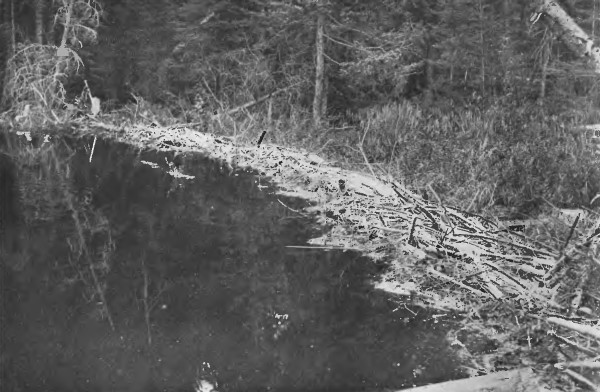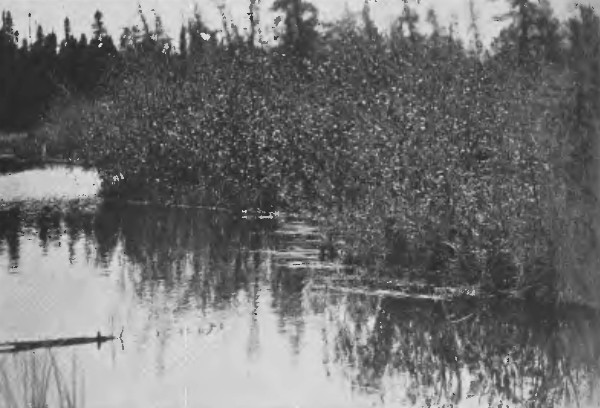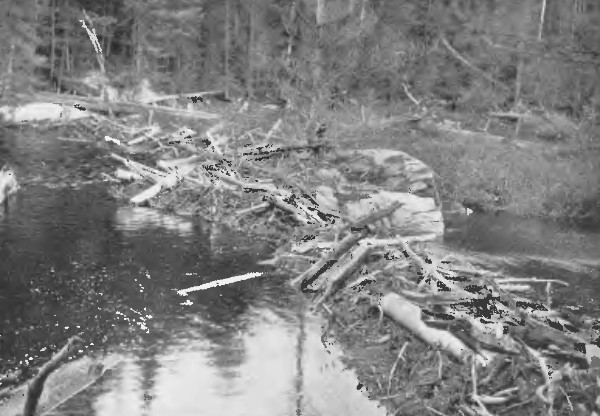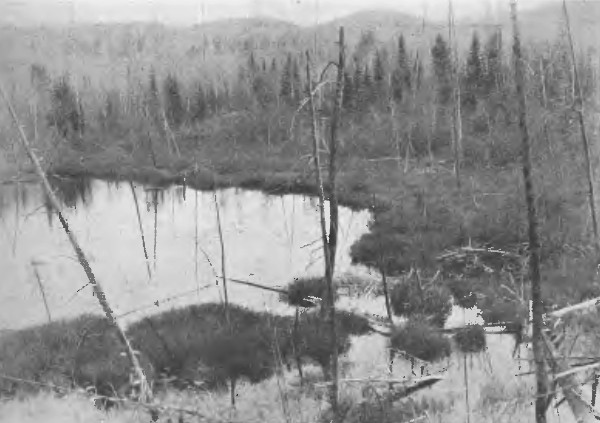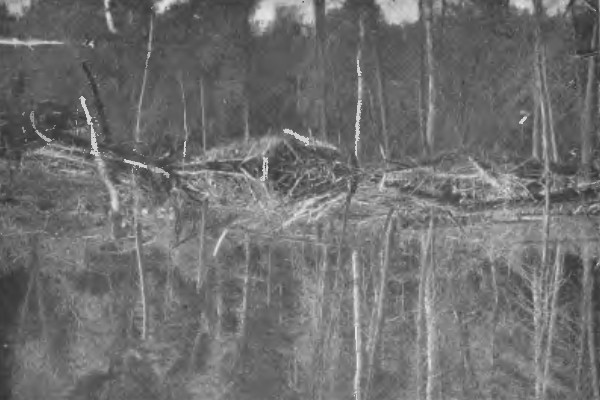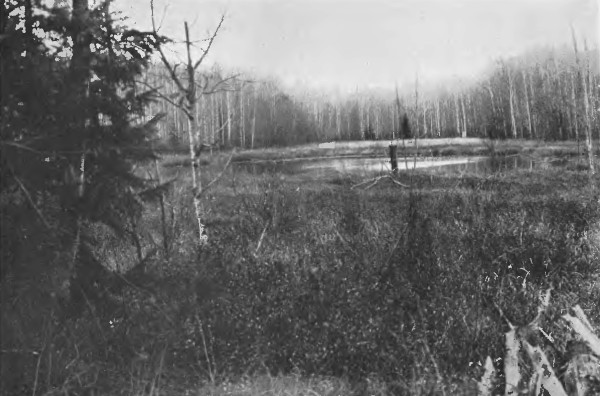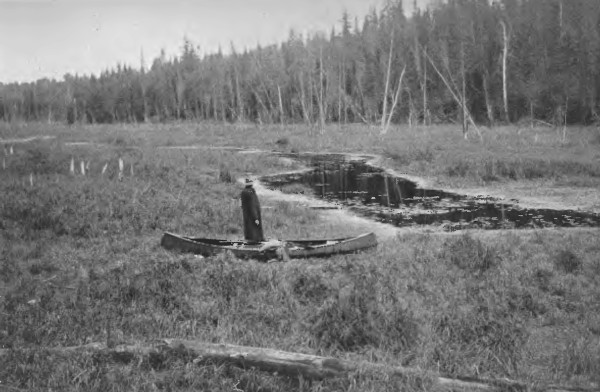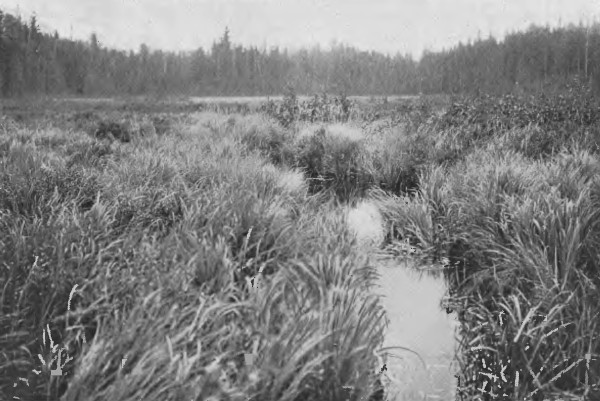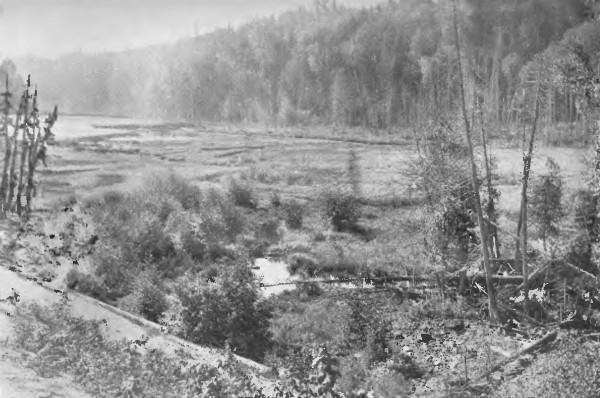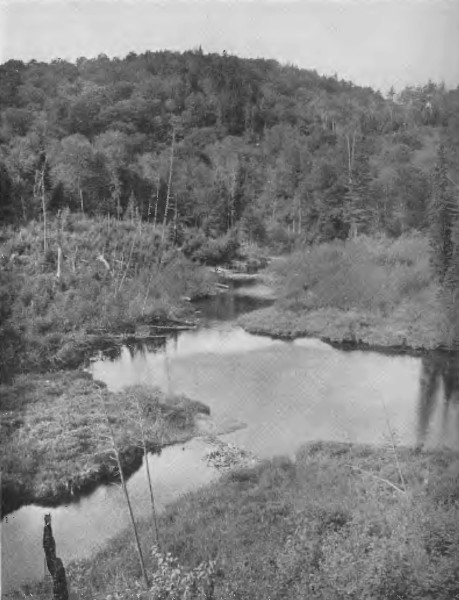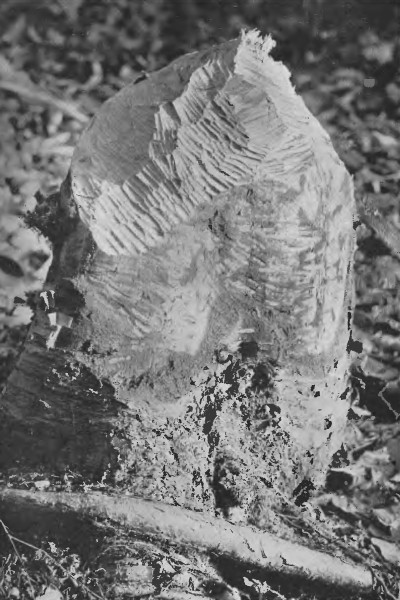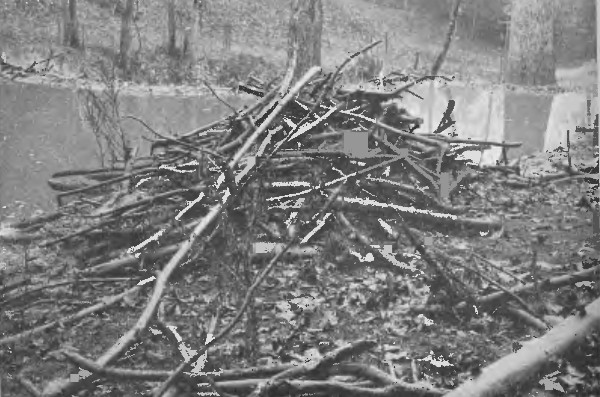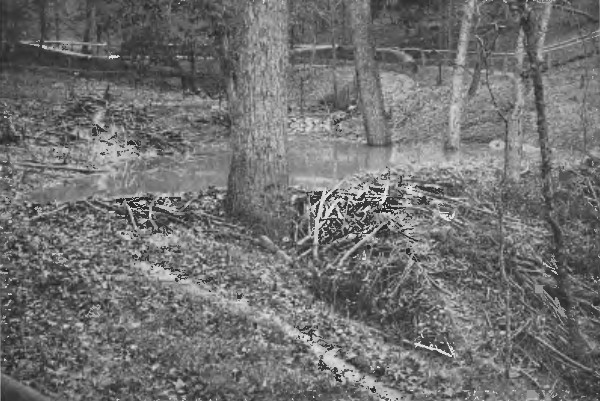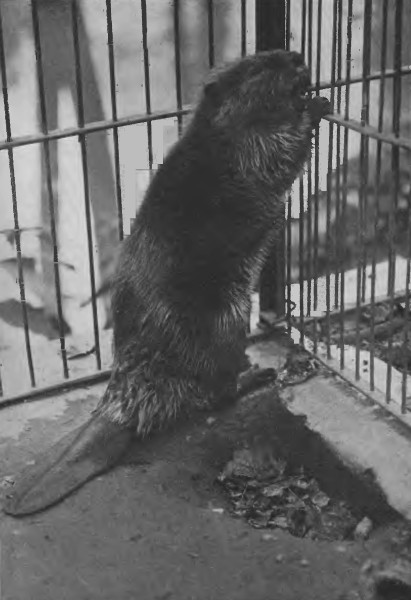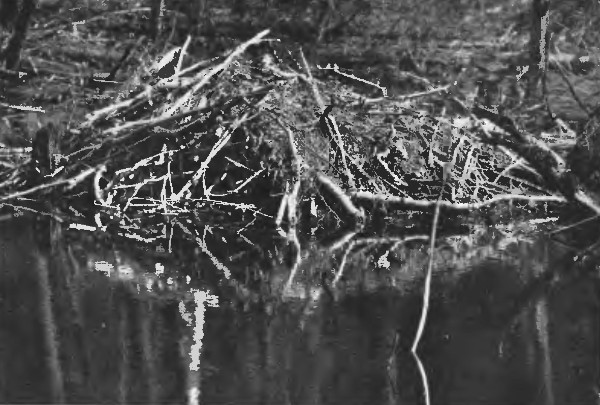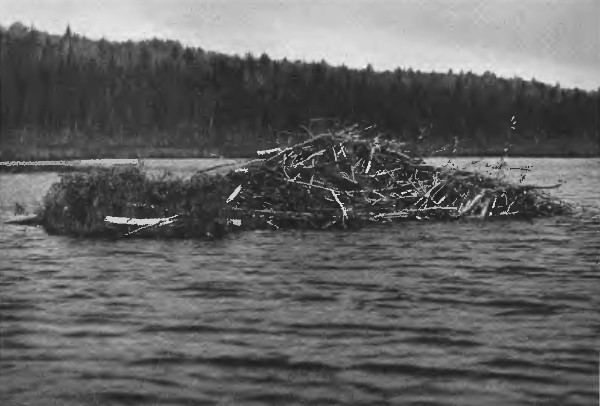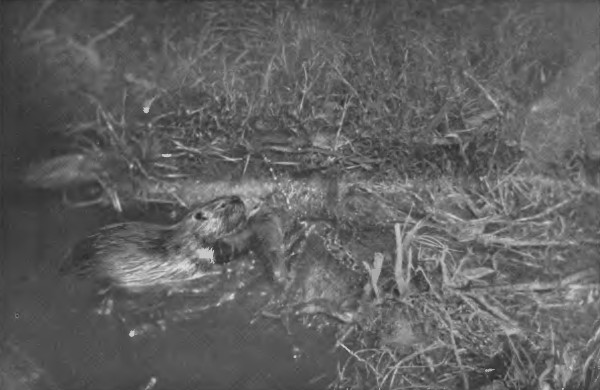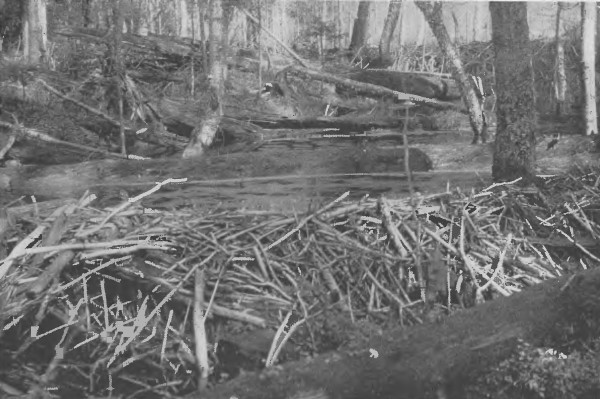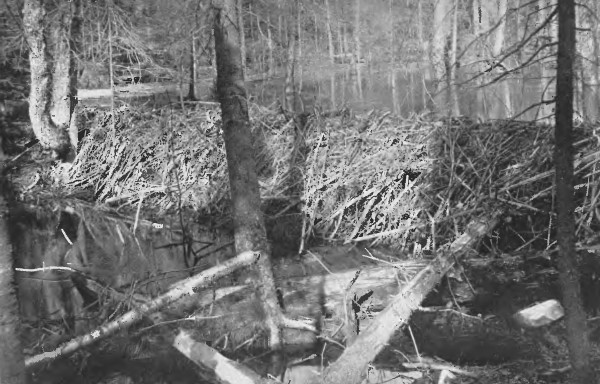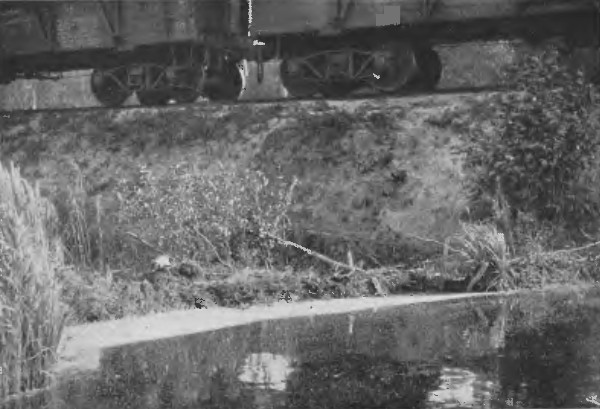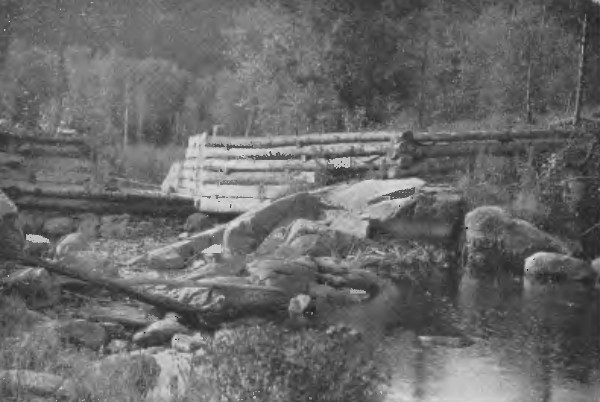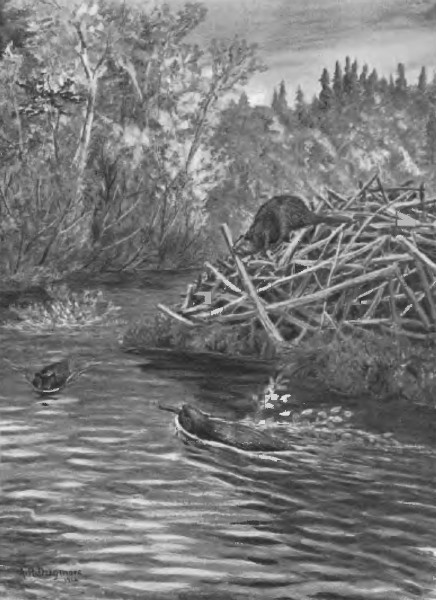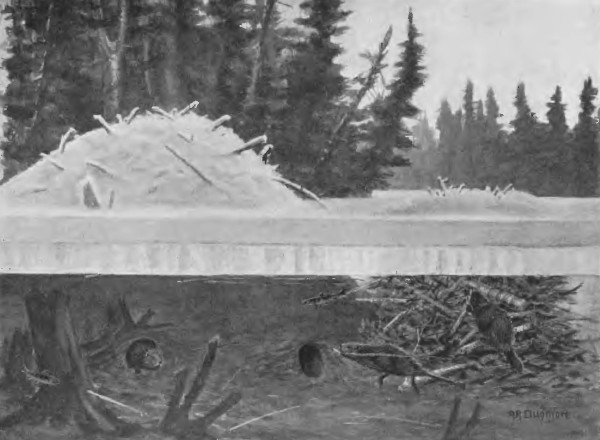| Web
and Book design, |
Click
Here to return to |
|
CHAPTER III RESULTS OF BEAVERS’ WORK - IN WHAT WAY MAN DERIVES BENEFIT FROM THE ENGINEERING FEATS OF THE COUNTLESS GENERATIONS OF BEAVERS-METHODS FOR THEIR PROTECTION IN the foregoing chapters the actual work done by the beaver and the immediate object of such work as it affects the animals themselves has been reviewed. We may now turn to the far-reaching results of what is done, and has been done by them during the past thousands of years, and the conclusion is forced upon us that the debt we owe to the beaver is of such magnitude that it can never be repaid. It is very doubtful indeed whether the work of any animal has such far-reaching results. Other creatures have been of greater value, either as furnishing food, or clothing, or means of transportation, but by themselves, unaided by man, they have done no work, they have accomplished little or nothing which has been of any direct benefit to man except in the way of killing our enemies, in which work birds take the highest place, for without their perpetual aid we should be overrun by insect pests, and be unable to grow our food crops. Slowly we are beginning to realise this and are making a fight against the dastardly destruction of these innocents for purposes of personal adornments and other equally useless objects. But the beaver is almost without any champion. He even has enemies who demand that he shall be killed for the harm he does to their particular interests. They do not stop to consider how they benefit by the results of the little animals’ work which far more than counter-balances any slight harm they do.
In this chapter I shall endeavour to show what the beavers’ work means. The question of the value of the animals themselves as fur bearers, and the results to the country from their pursuit, will come in a later chapter. We have seen that through making dams the beaver floods tracts of land which vary in size from less than an acre up to hundreds of acres, perhaps we might even say thousands. So long as these ponds or lakes are inhabited by the animals the dams are kept in repair, but gradually, as the size of the colony increases, the supply of food trees becomes more and more remote and the place eventually is unsuited to their needs, so the beaver move away and seek new pastures. In the natural course of events the dam, no longer kept in repair, soon begins to break down. Willows and alders take root and open up seams through which the water escapes. Running water soon enlarges any holes in earth works, and so within a short time the dams no longer hold back the water, the pond gets lower and lower until finally it vanishes. So much for the dam; now let us watch the pond itself throughout its course of existence. It began as a stream whose banks were probably wooded. As the water rose and flooded the land the trees, which had not been cut for food by the beavers, becoming choked by water soon died, and as the pond grew with each year’s additions to the darns, more and more trees were cut down for food and killed by water. What started as a pond of perhaps fifty feet wide and covering far less than an acre becomes a lake of fair size. Gradually the trees that have died fall and no trace of them is seen above water. Their roots may remain hidden in the ground to be dug up later as proof of the previous existence of the trees. Nothing remains to break the smooth surface of the lake except perhaps one or more beaver islands on which the lodges were built. After the place has been occupied by many generations of beaver it is abandoned owing to lack of food, or for the more dismal reason that the trapper had paid his visits of destruction to the peaceful colony, and the pond of maybe ten or a hundred years’ growth slowly subsides. During all these years there has been a rich land-forming process going along in an automatic way. The growing vegetation, having been killed by the rising water, has decomposed. Wood and leaves, grasses and roots, and even stones have become a homogeneous mass of material which under certain conditions makes soil. Year after year the trees on the surrounding hills and valleys have shed their myriad leaves, and these have been blown into the lake, or carried to it by the rains and melting snows. Débris of all sorts has been brought down to the flooded areas where in the still waters it all settles to the bottom so that gradually a deep vegetable muck has formed over the land that once was covered with trees and flowers and richly coloured mosses. Most of this refuse of the woods is under normal conditions carried down by the various streams into the rivers and so out to the sea and apparently man gets no benefit from it. But the beaver lake has arrested this valuable material and prevented it going to waste. Instead of being lost it has been stored up, not in one pond, but in hundreds of thousands, large and small. With the desertion of a beaver pond the water, as already stated, being no longer held in check by the well-built dams, gradually finds its way out. The subsidence may be slow or rapid, but the effect is the same. The whole area of flooded land begins to dry, and what was formerly a rough irregular tract has become smooth and level. For some time the water-soaked land is too heavy to allow of a good growth of vegetation, but it is opened and ploughed by the winter frosts, while the sun and the rains prepare it for its great mission. Grasses take possession and soon the lake becomes a meadow luxuriant, smooth and beautiful, a visible result of the beavers’ industry and the super-human direction of the power which controls all material things, and produces the greatest results from the smallest and most insignificant beginnings. How many acres of the finest meadow land and richest valleys are the result of beavers’ work no one dare say. But throughout North America it is fairly safe to say that many hundreds of thousands, or even millions of acres, of the finest cultivated land owe their existence to the beaver. Of course in most places all trace of the origin of these bottom lands is lost, but every once in a while a beaver-cut stump is discovered by those who have to dig down a few feet below the surface, and in some cases these evidences of beaver work have been found fully thirty or forty feet down, where for countless ages they have been preserved by the peat which has formed over them. Agassiz, speaking of the age of beaver work, mentions the building of a mill dam which necessitated some excavating. “This soil was found to be peat bog. A trench was dug into the peat twelve feet wide, by twelve hundred feet long, and nine feet deep; all the way along this trench old stumps of trees were found at various depths, some still bearing marks of having been gnawed by beaver teeth.” By calculating the growth of the bog as about a foot a century there is fairly good evidence that the dam built by the beaver must have existed about one thousand years ago.
Do the farmers realise what debt they owe to the beaver? I fear not. Their one idea if a beaver is found anywhere within their property is to immediately kill it. For they regard its wretched skin, worth perhaps ten dollars at most, as being the only value of the beaver, and so the wretched beast is caught and its skin saved, while the brains which have accomplished so much are thrown to the dogs. Who is to blame for this? Those who have the teaching of our children. If only the schools taught more about the usefulness of animals and birds, even from the selfish point of view of their results to men, and taught these things intelligently, much good would come. But a trip into any part of the country where the beaver still exists in its wild state will show how blind people are to their own interest in allowing these animals to be destroyed. Before going further into this side of the question it might be as well to show some more ways in which the beaver is of almost unlimited benefit to mankind and the country in general. Water, as we well know, is the most essential of all things; on its supply a country thrives or perishes. Millions of pounds are spent annually to protect and conserve the supply, so that towns and farms, and forests too, shall have all that is needed. With the opening up of country and the consequent destruction of forest land, the supply is inevitably bound to decrease, as the thousands of smaller streams are deprived of the shelter which prevents the rapid evaporation of the water; the result is of course the lessening of the amount in the larger rivers. At certain seasons the supply is too great, and floods do infinite damage. At other times there is a great shortage. Man, in order to prevent this uneven supply, builds enormous darns which retain the water during the season of plenty, and deal it out as needed during the hot summer months. But even with man’s most carefully arranged plans and vast expenditure of money, we hear of periodic water famines, with the resulting hardships which have such far-reaching and disastrous results. But what, may be asked, has this got to do with beaver? A glance at the work of those small animals will answer the question. Their dams, built most often near the head waters of streams, result in countless reservoirs, which keep the water in check and allow only the steady flow of a small amount, so that droughts in a beaver country are almost unknown, as there is always a sufficient supply kept in reserve. In some few parts of the country stock owners have begun to realise this important fact with the highly satisfactory result that these men are protecting beaver, which they regard as of the utmost value, because they can actually see the benefits which result from the work of these insignificant engineers. In the western States this exhibition of the importance of the beaver is most in evidence, and we may hope that other parts of the country will eventually, and before it is too late, follow in the footsteps of those men in South Dakota and other places who have set such good example. Apart from the conserving of water, the darns play another and almost equally important part. Floods, as already stated, are a source of almost unlimited trouble to both the farmer, the lumberman, and the villages. In fact everyone may indirectly suffer from the effects of too much water. Bridges are destroyed, roads rendered impassable and endless confusion is the result. The following piece of news is more eloquent than any words of mine on the subject. It appeared in the Gazette (Montreal) in the issue of September 9th, 1913. Curiously enough, I was on my way to carry on my studies of beaver in Ontario when it happened to catch my eye.
BURSTING
OF BEAVER DAM. “VANCOUVER, B.C., September 8. — All trains held up on the main line of the Canadian Pacific by slides are now on their way east and west. The line was finally cleared at eleven o’clock this morning. Yesterday the population of Field, the town nearest the slide, which occurred between Pallises and Glenogle, 25 miles west of Field, was increased by the addition of 2,000 passengers who were held up by the delay. “The slide, which was 300 feet wide and 30 feet deep, was caused by the bursting of an old beaver dam high up in the mountains. District Supt. MacKay, at Revelstoke, says that the dam burst under the pressure of heavy rain storms last week. The slide carried the track away completely and it went clear across the Kicking Horse River, damming that stream and endangering the track above the slide. The river was completely blocked up, and it was found necessary to blast a new channel for the stream to release the pent-up waters which threatened to cause a washout further east. The Canadian Pacific Railway had two steam shovels and a hundred men at work. Huge trees were brought down with the slide and boulders nearly as big as a box car made the job of clearing the track a difficult one. Some of the trees that came down bore the marks of the little animals’ teeth, and the supports of the dam erected by the beavers were plainly marked as such by the bleaching of their upper ends and the lower points coated with mud and slime. “Those of the delayed westbound passengers who arrived this morning expressed themselves as very well satisfied with the manner in which they were treated by the company. “Fourteen trains, east and west-bound, were stalled by the slide. Some of the passengers were transferred across the wash slide over a narrow footbridge, and others who were bound east were routed down the Arrow Head Lakes and by way of the Crow’s Nest Pass east again over the main line.”
It is fairly safe to presume that the builders of the large dam had been killed some time ago, so that the structure, no longer in repair, broke under the pressure of the water. And yet the railway people are bitterly opposed to beavers being allowed to exist, because occasionally the animals dam the culverts, and so raise the water against the railroad embankments. No credit is given to them for the thousands of floods which they have prevented. The evil and not the good is noticed and the animals are condemned without a fair hearing. Their side of the case is too often entirely disregarded, and the sentence of death is pronounced to the misfortune of all concerned. I have frequently heard it argued by those interested in the lumber industries of Canada that the beaver should be killed off because they destroy so much timber. Even to the casual observer such an argument must appear little less than ridiculous. If the beaver is to be condemned on that score what might be said of the lumberman whose reckless waste of timber is apparent to all who visit the northern woods. But that is not a subject for this book. Our interest is in the beaver. Of course they cut down trees, cut them down in order that they may have food, just as the lumberman does that he and his family may live and earn a decent livelihood. The question is what sort of trees the beaver cut, and are they responsible for any real destruction? I doubt it. To begin with, the principal trees cut for food purposes are birch, maple and poplars of several species which grow in low lands or in valleys, where their development is seldom great. Only on the higher ground, known as “hardwood ridges,” do they attain a size which gives them a commercial value, so as a matter of fact few, if any, of the trees cut down by the beaver would ever be utilized by man. The greatest destruction is due to the killing of conifers by flooding their roots, and in this way we must acknowledge that a certain amount of damage may be charged against the beaver. But even so it is so slight that it is scarcely worth considering, except as an excuse for those who wish a pretext for voting against the preservation of the little animals, and whose actual reason is too often that they want the few dollars which the pelts might bring them. Having barely suggested three of the most beneficial results of beaver work (I say barely suggested, for the subject might well be carried much further and many facts and figures given which would prove the points still more convincingly) we might now turn to the less important effects of the work. Everyone who has ever been much in the wilds knows the value of water-ways. In a canoe a man may travel with but little trouble, and may even allow himself many comforts that are debarred from the pack if weight has to be considered. Every portage, when canoeing, is an undesirable change from the quiet monotony of paddling, so the wise man chooses, so far as he is able, a route which will allow the canoe to remain in the water as much as possible. Such a man knows the value of going through beaver country. Streams which might otherwise be dry, especially during the summer months, can usually be counted on to have enough water to float a canoe if the beavers’ darns are in repair, and so many a weary mile of portaging is avoided. Hundreds of miles have I travelled by canoe either alone or with some hardy woodsman, and hundreds of times I have blessed the little beaver for the streams he has kept filled. During such journeys, each time a dam is reached the canoe is hauled over it so that it shall do as little damage as possible, and by the paint marks on the sharp-pointed sticks I have known that many another man has had reason to bless the builders of those dams. One other man who has reason to wish the preservation of the beavers is the fisherman, as the deep pools made along the waterways offer a cool retreat for the trout during the hot weather, and even though it may be said that the dams restrict the freedom of the fish in going up and down stream there are opportunities during the course of each year when the water overflows to such an extent that they can get past almost any dam. The fishermen, therefore, should use their influence in urging protection for the conservers of water. Another and seldom considered result of beavers’ work is the effect it has on the topography of a country. Fresh streams and rivers are made and old ones diverted to an extraordinary extent by the building of dams and consequent forming of ponds. Even new springs are brought to the surface by the pressure of the water in these ponds. Landslides are prevented by reducing the force of streams, and in many ways quite unknown to us the continued work of the beaver has had its varied effects on the land. The whole question of preserving the beaver should receive most serious attention, for even apart from the sentimental side which deserves consideration, the practical value of the animals is undeniable. The idea of protecting the beaver is of long standing. As far back as 1634 in the Jesuit Relations, there are the following paragraphs : “We (the Jesuits) shall be able to instruct them (the Indians) easily and Beaver will greatly multiply. These animals are more prolific than our sheep in France, the females bearing as many as five or six each year. But when the savages find a lodge of them they kill all, great and small, male and female. There is danger that they will finally exterminate the species in this region (Three Rivers) as has happened among the Hurons who have not a single beaver, going elsewhere to buy the skins they bring to the storehouse of these gentlemen. Now if it will be so arranged that in the course of time each family of our Montaignais, if they become located, will take its own territory for hunting, without following in the tracks of its neighbours: besides we will counsel them not to kill any but the males” — (this is amusing advice as the two sexes cannot be told apart by their appearance) — “and of those only such as are large. If they act upon this advice they will have meat and skins in the greatest abundance.” In another volume of the same work we find that Father Le Jeune (1636) offers a suggestion in the following words: “In time, parks can be made in which to keep Beaver; these would be treasure-houses, besides furnishing us with meat at all times.”
It is true that to-day the prospect for their welfare is better than it was some years ago when their extermination seemed to be imminent. Fourteen years ago I spent weeks travelling by canoe through what was formerly one of the best beaver countries in Canada, in search of material for some drawings on beaver and their work, and though I had with me an experienced Indian, I only found one colony, a small one, in a pond many miles north-west of Lake Temiscaming. All other ponds found on this trip were deserted, nothing but the decaying lodges and dams marked the places where the beavers had been. Trappers had relentlessly pursued them from pond to pond, and scarcely any remained, notwithstanding the fact that they were even then supposed to be protected by law. In a big wild country it is far easier to make than enforce laws, especially as the law prohibiting the killing of the beaver was obnoxious to so many whose living depended largely on the trapping or selling furs, for of all fur-bearers the most easily obtained are the beaver. The law was in fact almost a dead letter as very few were interested in its being observed. About that time in Canada certain men began to realise the value of proper game reserves, and be it said to their everlasting credit they succeeded in influencing the Government to carry out their ideas. In the United States, Colonel Roosevelt was one of those most active in the work of conservation and in establishing reservations, and if he had done nothing else during his strenuous life he would be remembered by what he did in that direction. In Canada, several great “parks” or reserves were established, one particularly I know of which was designed for a “fish and game preserve, health resort and pleasure ground for the benefit, advantage and enjoyment of the people of Ontario, and for the protection of the fish, birds, game and fur-bearing animals therein,” etc. Leaving aside all other animals and birds, we will see how it affected the beaver. The tract chosen was admirably adapted to their needs, and they soon found themselves, as they thought, safe from the continual dread of the steel trap, so that new colonies established themselves and increased most wonderfully. But the wretched beasts were lulled into a false security, and what followed for obvious reasons cannot be recounted here. Sufficient is it to say that great numbers of beavers were killed by authority, the number caught and killed in a single year I dare not mention, but under the clause which reads: “Upon the report of the Minister that any species of fur-bearing or game animal or bird has increased to such an extent that its numbers may be lessened without detriment to the Park, or the purposes for which the Park was established, the Lieutenant-Governor in Council may authorise the taking or killing of such animals or birds not exceeding the number specified in Order in Council under the direction and supervision of the Superintendent of the Park,” and further, in speaking of furs, skins, etc., “May be sold by the Minister and the proceeds of the sales shall be applied toward defraying the expenses of the Park.” The unfortunate and, I venture to add, injudicious taking of beaver has continued. The results are unsatisfactory from two points of view. First, that the beaver has been captured in the most accessible parts of the park, so that one of the objects of the reserve is defeated. The underlying idea was that in protecting the wild animals, and so bringing them to a condition of comparative tameness, the people who came to this “fish and game preserve, health resort and pleasure ground” should have an opportunity of seeing the wild animals, the most interesting of all being the beaver, whose works are a positive education for young and old. But these people, of whom I have met many, are filled with disappointment and disgust when they are shown abandoned dams and lodges close to the resorts (within a few hundred yards of hotels and camps) and are told that the builders themselves have been trapped and either killed or sent away to zoological gardens or other parts. Such treatment is scarcely fair to the people and cannot be considered wise. The country is certainly rich enough to support the parks without the necessity of getting money from the sale of the animals which the people would far rather see alive and in their natural conditions than in “returns for sale of skins.” But the second objection is even more far-reaching though more subtle, because people do not generally grasp its significance. The trapper is told that the beaver are absolutely protected by law and that to kill one involves the offender in serious trouble, such as imprisonment, fine and confiscation of his traps. In other words, by strict Government orders beaver may not be killed. These trappers are usually men of fair-play who understand rude justice better than obscure reasonings. They believe that what is food for the goose is food for the gander, and that if they, who trap only as a means of livelihood may not kill beaver neither must anyone else, except possibly as specimens for museums or such special purpose, but that the Government should indulge in beaver killing for commercial reasons is past their understanding. To fully appreciate what I am speaking of it might be well to explain the situation a little more clearly. The land which has been set apart as a game reserve and park was formerly occupied by trappers who made their living out of the wild lands. According to their unwritten law, a man on establishing a claim has a right to a certain tract of country for trapping purposes. These rights are regarded as almost sacred, and the man who poaches on another’s boundary is held to be little better than a thief. These rights go from father to son, with the understanding, I believe, that if the land is not trapped for a specified number of years, the privilege is forfeited. In order to get possession of a desirable tract, men will go great distances and endure untold hardships, with the understanding that once they have succeeded in finding what they want it is to be theirs, unless sold by the Government. It will be seen by this that the best trappers who for years had set their line of traps through the land which is now a park felt their expulsion very severely. To make amends to them a few were taken on as rangers or wardens. The men, though feeling themselves in hard luck, realised at heart that it was after all for a good purpose, for well enough they knew that unless the beaver was protected it would be but a few years before they would be a thing of the past, gone to join the dodo and others that used to be. So they took their medicine like men, but when they saw that the park was being used for trapping purposes, and that the skins were being sold by the Government, their spirits rose in rebellion. More especially when they themselves as employees of the park had to take part in trapping the animals. They were for the most part quite willing to forego their share of beavers’ skins if the beaver was to be really protected, but they do not see the fairness of the present situation, and the result is that men who otherwise would have honestly observed laws which were for the welfare of the greater number are now in many instances doing their best to get a share of the spoils. They do not see that it is any longer a question of honour, for if beaver may be killed, why should not they as well as anyone else, reap the benefit? Laws relating to wild animals in a great country which has so small a population and so much wild land can only be of real value if they are in accordance with popular opinion, but just as soon as the public considers a law unfair the difficulties of enforcing that law become practically insurmountable. What I have written is not a matter of theory, but is the result of observation and conversation with the men interested in the question. There is absolutely no desire to tread on anybody’s toes, but rather to call attention to conditions which might so easily be remedied, for my interest is simply with the beaver, and with protection of wild life in general.
I know it has been asserted that beaver were too abundant in a certain park, but whether the assertion was justified by facts I have serious doubts. At any rate, before radical measures were adopted, it would have been advisable to have had the expert opinion of an entirely disinterested person, or, better still, of many persons, and if their findings resulted in a disagreement then the beaver should have had the benefit of the doubt. In Newfoundland the question of beaver protection needs most serious consideration and a definite policy lined out for future plans. Eleven years ago I first visited that country, and each succeeding year until 1912, when I was last there. During that period of ten years ample opportunities were afforded me of observing the beaver and the extraordinary results of what protection can do. During the first four visits to the island I never saw but one beaver colony, and that a very small one in a remote and inaccessible part of the country. In 1912 I counted no less than twenty-seven occupied lodges within a short day of walking and canoeing. What has happened in that one district is simply an indication of what might be expected elsewhere, and goes to show how rapidly the whole country might be re-colonised by the interesting animals. Their abundance would be a great source of pleasure to all who visit the delightful island, and would add one more to the list of attractions which it has to offer. The one condition which has retarded the increase of the beaver is that the law for their protection has been so often changed. The harm done is that each time the close season was drawing to an end, beavers were surreptitiously killed in anticipation of the time when the skins might legally be offered for sale. Then almost at the last moment the close season would be extended for another few years, very much to the disgust of those who were storing skins at considerable risk, for, justly enough, their discovery would mean a heavy fine. It can scarcely be doubted that fair numbers of beaver were killed by those who wanted to be ahead of their neighbours, for competition must have been keen. An animal which is as easily trapped or in other ways killed, as the beaver, requires the most careful protection, and laws should be considered with the most thorough understanding of the conditions governing their life and the trappers’ powers. Had the close season (in Newfoundland) terminated two years ago, the entire good gained by the preceding years would have been lost. For the trapper, having learned by experience that laws can be made and suddenly changed for the protection of the beaver, would have made the most of the opportunity and practically every colony would have been sacked within a very few months, and small indeed would have been the number of survivors. How to devise a sound scheme which would be fair on both trapper and beaver is no easy task. But the Government has been so careful and far-sighted in its game laws, having set a standard which might well be considered by other countries, that I offer these suggestions with due humility in the hope that they may do some good. To open up a definite tract of country for a certain period has the disadvantage that it would mean the killing off of every beaver in that tract, and would entail a great deal of expense to the Government in the way of patrols in order to prevent poaching in the closed territory. Probably the soundest scheme would be to licence every trapper, and furnish him with a limited number of labels, one to be attached to every beaver skin before allowing it to be sold. This would serve the double purpose of limiting the number of beaver killed, and keeping track of the total amount with the least expense. Of course it would be necessary to make the selling of any unlabelled skins absolutely illegal, with punishment severe enough to make it effective. Imprisonment alone could do that, as the penalty would be most likely to fall on those to whom the very name of prison is most appalling. The number of labels issued should be strictly limited with due reference to the number of beaver. No beaver should be taken until they are thoroughly established and really abundant, neither should they ever be molested in the reserves under any conditions, in order that people might have the opportunity of seeing them living peacefully and without suspicion. Fortunately they are amenable to protection and they adapt themselves readily to new conditions. In zoological gardens and private parks they do remarkably well, even though they can never be said to be show animals in any sense of the word when in captivity, owing to their crepuscular and nocturnal habits. The following account of an experience I had with beaver in the Washington Zoological Gardens may be of interest, for even though it was published elsewhere many years ago it still shows something of the animal in captivity.1 THE OUTCAST A TRUE STORY OF A CAPTIVE BEAVER IT is difficult to imagine a more pathetic sight than that of the poor old beaver solitary and so entirely alone, within sight of his comrades yet not among them, unable to join in their games and their work, living his lonely life like a hermit; within sight of his fellow men, but separated by a barrier as strange as it was secure. After I had waited for many hours watching quietly in the small enclosure above the large beaver pond in the Washington Zoo, there was a movement in front of the large hollow opening out on the water, and a head peeped out to see that all was safe for the owner’s regular evening exercise. The sun had long since disappeared behind the hill and everything had the quiet hush of evening. The deep roaring of the lions and tigers and the more distant barking of the seals alone disturbed this silence, when the beaver, fancying himself alone, plunged noiselessly into the water, diving beneath the log that lay partly submerged but a few feet from the narrow entrance and reappeared in the middle of the small pond. Almost like a short piece of drift wood he lay with his tiny dark eyes gazing intently at me where I stood in the shadow of a small tree. Observing no movement and not being of a suspicious nature lie soon swam to shore and immediately walked, moving for all the world like a large smoothly coated Canadian porcupine, straight to the corner of the fence that divided him from his relatives. Once there he stood on his hind legs and tail, and with front feet resting on the horizontal bar, he gazed, with a longing wistful look shown by his entire attitude, at the lodge in which the other beavers lived. Never surely was loneliness shown more eloquently than by this soft furred animal as he stood there, the very picture of solitude in the midst of so many, as a stranger in a city where the fences of convention, bars as rigid as those which surrounded this beaver, keep him from personal intercourse with his fellow men. For ten minutes he remained thus, motionless except when, as though no longer able to contain his misery, he would bite the hard, cold bars of iron, as he had bitten them every evening for three, long, weary months. Did he imagine that perhaps some day he would find the bars had softened and would yield to his chisel-edged teeth, teeth that, were the animal in his native land, would work their way through anything save the stones or the cruel metal of the merciless steel traps? These alone would defy them.
Wishing to examine more closely the interesting animal I approached quietly, hoping not to disturb him, but he felt uncertain of my intentions, and before I had lessened the distance between us by more than a few steps, he dropped on all fours, and after regarding me curiously for a minute or two turned and made for the water. Once there he felt more secure, for at the slightest sign of danger he would, as he had done many times in his far-off Canadian wilds, dive in and loudly slap the water with his tail to warn his friends and then instantly disappear from view beneath the water and make straight for his burrow. His curiosity, however, soon got the better of his natural timidity, and out he came with the usual quiet splash and dive. This time I stood near his regular landing place, which was as clearly marked as an otter’s slide, and wondered whether he would venture near. Slowly he swam towards me, stopping repeatedly to investigate. What it was that gave him confidence I could not tell, but suddenly he apparently made up his mind that there was no occasion for fear and he moved quickly, landing within three feet of where I stood. Once on shore he again doubted the wisdom of his course and hesitated, not quite liking to pass so near a human being; sitting half way up on his hind legs and tail with his small fore paws held close beneath his chin he carefully watched me, his nose moving slowly as though trying to scent an enemy. A few minutes sufficed for this, and then we had established a degree of mutual confidence at once satisfactory and useful, for I hoped on the following day to take a few photos of my new friend, and it is highly desirable that we should be on a footing of trust with our model. It was rapidly becoming dark, too dark, indeed, for me to distinguish much more than the general form of the beaver. So I left him to his thoughts, intending to visit him again the following afternoon. That the reader may understand something of the position of this poor old hermit a few words of explanation are needed. When the beavers were first brought to the Zoo they were given for their new home a small enclosure of perhaps two acres. Through this ran a very small stream, the banks of which were fairly well wooded. It was but a short time before the industrious animals commenced work; the stream was so small that they were unable even to swim in it, so a dam was planned and rapidly constructed. Trees were felled, some of which were nearly eighteen inches in diameter; from these the branches were cut, then divided into convenient lengths and used in the dam building; the bottom of the stream was dredged and the mud and roots used to finish off the structure and make it watertight. The number of trees decreased so rapidly through the industry of those four-footed engineers that it became necessary to protect those that still remained unharmed with heavy wire netting. This at first was fastened to the tree in direct contact, but it was soon discovered that the beavers could cut the tree between the meshes. To prevent this an iron rail, to which the wire was attached, was placed at a little distance from the tree. The dam was by this time fairly large, but not as large as was needed. More material was needed, so a great quantity of cut wood was thrown into the enclosure and was immediately utilised by the beavers; in a short time the level of the water was raised many feet with the result that a pond of considerable dimensions was formed. Three other dams were also built down stream from the main structure, about fifty feet apart. It was late summer by the time this work was accomplished, and a house had to be built with as little delay as possible, for with the arrival of cold weather all building operation must cease as the mud freezes and of course becomes too hard to work. The house or lodge, as it is more properly named, is outwardly a great mass of loose sticks, some of which might from their size be called logs, filled in with earth and roots and covered over with mud. In the centre very little mud is used, for there is a sort of irregular chimney, which serves as a ventilator. Inside the house all is darkness or very nearly so. The walls are rough, but the floor, which is raised a few inches above the water, is firm and smooth, made of fine twigs beaten into the earth. The entrances, for there are usually two or more, are several feet beneath the water. What impressed me on seeing the lodge and dams built by the beavers in the Washington Zoo was the fact that in no way did they differ from those in the most remote part of Canada. When spring came it was found that the beavers had increased in numbers, very much to the delight of all concerned, but the following year, when they were all full grown, the rules and regulations of beaverdom were put in force. They decided that there was one too many, and according to their laws he must either betake himself to some other locality or submit to an untimely death. Now, the victim chosen — whether by ballot or by whatever means who can say? — was our old friend, and as it was impossible for him to leave the colony of his own accord, death would have been his lot had not the keeper come to the rescue and given him a cage where he might live until a better place could be provided. It was two or three months before he was turned into the enclosure in which I found him. This bordered on his old home and was separated only by an iron fence. Being a solitary bachelor he has not as yet set up housekeeping; perhaps he thinks it scarcely worth while building a house until he has a mate. As it is he has made a burrow in the bank with the entrance at the level of the water. In this he spends his days, seldom coming out at all before sunset, frequently much later. When out he spends much of his time watching his old companions, while they in turn seem to take but little notice of him. So much for the reason of his being alone. On
the occasion of my second visit to this solitary beaver I
brought my camera, with the fond hope of being able to secure a few
photographs, even though the light might not be suitable for such
work. It was nearly five o’clock before he made his appearance, and
then, as on the day previous, after emerging from his burrow, he
lay quietly on the water taking in the situation before daring to
come ashore. I had placed the camera so that if he went to his usual
corner it would not be necessary to move it. After satisfying himself
that all was well he landed and walking past the camera took up his
position at the fence corner.
Standing erect as on the previous day he gazed intently at the home of his old friends. They had not yet made their appearance, but from their lodge came the sound of muffled voices, for they were holding an animated conversation in beaver language, which sounds like a strange subdued mixture of children’s voices and very young pigs squealing, varied now and then by a puppy’s cry. Whether or not our beaver understood the drift of their discussion would be difficult to say, but certain it is that he seemed to be very much interested by it all. While he stood there almost as motionless as a statue, I made several exposures, bringing the camera nearer and nearer each time; when within almost five feet he turned round to examine the strange one-eyed monster that was approaching so quietly. It evidently puzzled him without frightening him. After a few moments his curiosity got the upper hand and he came straight for it, slowly of course, and hesitating slightly at each step. As he came nearer I retreated that I might the better see what he would do. To begin with each leg of the tripod was scrutinised most carefully; these he evidently concluded were harmless, so resting his hands on one of the legs he reached up and took a good look at the camera itself. His nose must have discovered some new odour, for he sniffed first on one side then on the other for many minutes; suddenly his attention was attracted by the rubber ball belonging to the shutter. This was moving at the end of the tube, and he thought that perhaps it was something new in the way of food. In another moment the bulb would have been rendered useless, for his sharp teeth would have instantly punctured it. At this critical moment I had to interfere, very much to his disgust, as the poor old chap evidently thought he had been robbed of a delicious morsel, and I regretted not having brought a carrot or sweet potato for him. Wishing to make friends with this strange animal, I sat down near the camera. Immediately he came near, so near that I could put my hand on his soft, furry back, wondering at the time what would happen if he should take it into his head to use his teeth. For with their extraordinary strength and sharpness the amputation of a finger or two would have been the work of an instant; however, he was a very well meaning old fellow and contented himself with walking slowly round me, stopping occasionally to sit on his hind legs and take a general survey of the curious being who went about with the three-legged thing — the camera. Satisfied that he might safely leave me for a short while he went to his corner, and after looking for a few minutes at his neighbours who were swimming about in their pond he went down his path to the water’s edge, and in his own peculiar, noiseless way, plunged in for a swim. He soon discovered a stick upon which some bark still remained. This he brought ashore and holding it with his front paws, or hands as they might well be called, proceeded to make a meal therefrom. It required but a few minutes to strip the stick of its bark, after which it served no further use and was left in the water while the animal swam around making a tour of investigation, which resulted in his not finding anything more suited to his taste. So coming ashore near where I stood, he commenced his evening toilet, which was interesting to watch. To begin with, instead of sitting with his large flat-ribbed tail protruding behind him he tucked it forward between his hind legs and sat upon it. Then with his hands he carefully combed his long fur, using both hands at the same time. There were, however, many places that he could not reach in this way, for his arms are very short. So with one hind foot at a time he combed these otherwise inaccessible parts; the entire operation was performed with the utmost deliberation and care, and occupied nearly twenty minutes, so that by the time it was completed the daylight had almost vanished. My presence did not appear to disturb him in the very least, though I sat quite close that I might the better note his various attitudes, for it is not often one has an opportunity of watching a beaver at such close range. Suddenly the night watchman, whose duty it is to feed the nocturnal animals, arrived with a basket of stale bread and vegetables. These he threw into the enclosure, the vegetables on the bank and the bread into the pond. Mr. Beaver well understood the meaning of those splashes, for he instantly made for the water, utterly regardless of his newly dried jacket about which he had taken so much trouble, and seizing one of the loaves of bread in his hands swam to a shallow part of the pond to eat it. He held the bread in his hands, much after the manner in which a squirrel holds a nut, but the bread being wet began to fall apart so he made a bowl of his hands and lapped the soft bread out of it; in this way not a particle was lost. Piece after piece of bread was eaten, after which he came ashore and made short work of the carrots and potatoes. It was quite dark by this time, and as it was impossible to see anything more I was forced to leave him, with the hope that in the near future I might continue the acquaintance so pleasantly begun. When that day comes let us hope he will no longer be solitary but will have taken to himself a mate whose disposition will be as good as his own. From what has been said in the preceding pages, it will be seen that the beaver is a gentle creature, free from desire to harm anybody. As pets they become extremely affectionate and dependent on their masters. Mills2 describes an interesting experience with a pet beaver to which he became deeply attached. “Atop the pack on the horse’s back he travelled,---a ride which he evidently enjoyed. He was never in a hurry to be taken off, and at moving time he was always waiting eagerly to be lifted on. As soon as he noticed me arranging the pack, he came close, and before I was quite ready for him he rose up, extending his hands in rapid succession beggingly, and with a whining sort of muttering pleaded to be lifted at once to his seat on the pack.” There are many instances of Indians having tame beavers, some of which grew up in the family having been taken as kittens and nursed by the squaws. From this and all other accounts the beaver is shown to be a delightful pet, cleanly in habit, good-tempered, quiet and gentle. The only objection to them is their predilection for mistaking chair and table legs for growing trees and cutting them down. The fact that they cut down trees is rather a serious argument against having them at large in private parks. The only way to keep them and not suffer from their peculiar habits is to set aside a portion of a stream for their use, and have a vigorous growth of aspens or some equally quick-growing tree partitioned off into small lots. A low iron fence is sufficient to keep the beaver out and they could be allowed access to one part until they had fairly well cleared it of timber. A certain number of trees could always be safeguarded by means of wire netting. The animals, having to do the work of cutting, would keep in good condition, far healthier and more vigorous than if fed with cut up food. In order that the supply of growing trees be not too rapidly depleted, some scraps of brush or poles could be given occasionally. Sir Edmund Loder has a very ingenious scheme for feeding the small colony of beaver that he keeps in his fascinating place in Sussex. A small hole filled with several large stones serves as a holder for trees or poles or even stout branches, so that the beaver, in order to obtain the bark, must cut it down just as they would if it were a growing tree. Unfortunately most of this colony was carried away by a great flood, the animals being eventually killed in the sea by fishermen who were much puzzled by seeing such unusual creatures swimming about in the harbour. All large trees in a beaver enclosure must be very carefully protected, for no matter how large they may be, the beaver will girdle them and eat the bark. Most of the work done by the animals in their wild state will be almost equally well done in captivity, so that a small beaver colony is always an object of intense interest and may be maintained at comparatively small cost in money and labour. It is to be hoped that as people realise more fully the interest and value of these animals they will take steps for their protection in all countries suited to their needs. It would indeed be a shame to see such creatures exterminated. There would be nothing to take their place, and I find wherever I go, and whatever class and age of people I am with the subject of beaver and their work is always of interest, far more so than any other animal. For whether a person knows anything of animals or not, the extraordinary engineering feats of the beaver, their home life and habits, compel attention. It is a pity that there is not a broader knowledge on the subject, so that those who are in a way making their living from the results of the little animals’ work should realise to whom they owe the debt.
When the first settlers came over to North America, they found a wilderness where they wanted to start their new homes. They most often selected what they considered the natural meadows for their homesteads. These broad valleys in which they found rich luxuriant grasses waving in the summer breezes appealed to them. In such places their cattle would feed in comfort and abundance. Hay too could be gathered to fill their rude barns, that their stock might be well fed during the long hitter winters. The meadows always contained a stream where the animals could be watered without trouble. In fact the pioneers found farms almost ready made, awaiting only the plough to turn the rich soil into the finest crop-producing land. And all without the tedious labour of clearing, and only those who have attempted such work can realise the amount of labour involved in clearing thickly timbered land. But a small part of the work can be done during the slack winter season, during which time trees are cut, but the hard stumps are frozen into the ground, and not until the soft rains have thawed the earth can they be removed. Rotting them out is a slow process involving many years during which cultivation of the stump-strewn land is difficult and unsatisfactory. Blasting them out is far too expensive for the poor settler, so that every acre of ready cleared land means a tremendous saving of labour; and what is even more important, the forest land, though it may be fairly rich, does not compare in fertility with that of the meadows, and is of course usually so rough that cultivating is far more difficult. But the farmer who thus reaped the benefit of countless ages of beavers’ work had no thought for the little fellows. On every possible occasion he trapped them, though perhaps the very ones he killed were the direct descendants of those that had originally built the dams which had made the meadows for him and his family. His house might even be built on the site of the original lodges, and years later a village or a town be built around the same place. Factory whistles might scream to thousands of busy men and women, calling them to begin or finish their day’s labour where formerly the evening call of the owl had summoned forth the beaver to their night’s work. The saw mill on the old beaver pond might screech as its many-toothed, buzzing saws tear through the heart of the stoutest trees, in the very place where years ago the trees had been cut by the keen-edged teeth of the beaver. Ship canals might be built where the furry little engineers had built their canals. Great stone dams form reservoirs where the primitive earth and log dams had once held water for the beaver. We are a busy people and we can give but little heed to sentiment, but surely there is time in our lives to think of preserving and protecting the beaver. Let us hope that the generations who follow us will be able to thank us, their forefathers, for having defended the beaver when they look on these small creatures continuing the work their Creator intended they should do. We owe that much to our descendants, and we owe still more to the beaver.
1 First published in Everybody’s Magazine. 2 “In Beaver World.”
|

